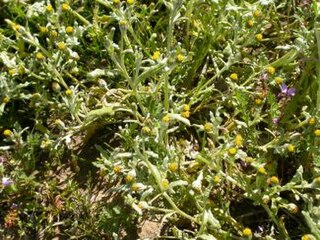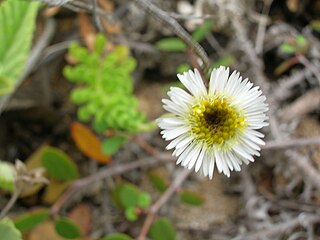Melicope balloui, also called Ballou's melicope or rock pelea, is a species of plant in the family Rutaceae. It is endemic to the Hawaiian Islands. It is threatened by habitat loss. Like other Hawaiian Melicope, this species is known as alani.

Monolopia congdonii is a rare species of flowering plant in the family Asteraceae known by the common name San Joaquin woollythread. It is endemic to California, where it is known only from the southern San Joaquin Valley and one area in nearby Santa Barbara County. It is a federally listed endangered species.
Blennosperma bakeri is a rare species of flowering plant in the daisy family known by the common names Baker's stickyseed and Sonoma sunshine.
Pseudobahia bahiifolia is a rare species of flowering plant in the family Asteraceae known by the common name Hartweg's golden sunburst.

Cyanea remyi is a rare species of flowering plant in the bellflower family known by the common name Remy's cyanea. It is endemic to Hawaii, where it is known only from the island of Kauai. It is a federally listed endangered species of the United States. Like other Cyanea, it is known as haha in Hawaiian.

Cyperus trachysanthos is a rare species of sedge known by the common names pu`uka`a and sticky flatsedge. It is endemic to Hawaii, where it is known from Kauai and Oahu. It was known from Niihau, Molokai and Lanai, but it has been extirpated from these islands. It is a federally listed endangered species of the United States.

Diplazium molokaiense is a rare species of fern known by the common name Molokai twinsorus fern. It is endemic to Hawaii, where it is one of the rarest ferns. It has historically been found on the islands of Kauai, Oahu, Lanai, Molokai, and Maui, but it is thought to have been extirpated from four of them and today can be found only on Maui where fewer than 70 individual plants remain. The fern was federally listed as an endangered species of the United States in 1994.

Kadua cordata is a species of flowering plant in the coffee family known by the common name kopa. It is endemic to Hawaii.
Cyperus fauriei is a rare species of sedge known by the common name alpine flatsedge. It is endemic to Hawaii, where it grows on the islands of Molokai and Hawaii. It is a federally listed endangered species of the United States.
Melicope munroi is a rare species of flowering plant in the family Rutaceae known by the common names lanahale and Munro's pelea. It is endemic to Hawaii, where it is known only from the island of Lanai. It is a federally listed endangered species of the United States. Like other Hawaiian Melicope, this species is known as alani.
Schiedea helleri is a rare species of flowering plant in the family Caryophyllaceae known by the common names Heller's schiedea and Kaholuamanu schiedea. It is endemic to Hawaii, where it is known only from the island of Kauai. It is threatened by the degradation of its habitat. It was federally listed as an endangered species of the United States in 1996.

Silene lanceolata is a rare species of flowering plant in the family Caryophyllaceae known by the common names Kauai catchfly and lanceolate catchfly. It is endemic to Hawaii, where it is known only from Oahu, Molokai, and Hawaii, having been extirpated from Kauai and Lanai. It is threatened by the degradation of its habitat and it is a federally listed endangered species of the United States.

Spermolepis hawaiiensis is a rare species of flowering plant in the carrot family known by the common name Hawai'i scaleseed. It is endemic to Hawaii, where it is known from the islands of Kauai, Maui, Oahu, Molokai, Lanai, and Hawaii. It is threatened by the degradation of its habitat and it is a federally listed endangered species.
Tetramolopium arenarium is a rare species of flowering plant in the family Asteraceae known by the common name Maui tetramolopium. It is endemic to Hawaii, where it is known only from the island of Hawaii. It is extirpated from Maui. It is threatened by the degradation of its habitat. It is a federally listed endangered species of the United States.
Tetramolopium capillare is a rare species of flowering plant in the family Asteraceae known by the common name pamakani. It is endemic to Hawaii, where it is known only from the island of Maui. There are four occurrences for a total of fewer than 200 individuals. It is threatened by the degradation of its habitat caused by introduced plant species. It is a federally listed endangered species of the United States.

Tetramolopium lepidotum is a rare species of flowering plant in the family Asteraceae known by the common name Waianae Range tetramolopium. It is endemic to Hawaii, where today it is known only from the Waianae Mountains on the island of Oahu. It is threatened by habitat degradation caused by feral goats and pigs and introduced species of plants.

Tetramolopium rockii is a rare species of flowering plant in the family Asteraceae known by the common name dune tetramolopium. It is endemic to Hawaii, where it is known only from the island of Molokai. It is threatened by habitat destruction and degradation caused by deer, cattle, introduced species of plants, and off road vehicles. It is a federally listed threatened of the United States.
Trematolobelia singularis, the lavaslope false lobelia, is a rare species of flowering plant in the bellflower family. It is endemic to Hawaii, where it is known only from the Koʻolau Range on the island of Oahu. It is threatened by the degradation of its habitat. It is a federally listed endangered species of the United States.

Vigna owahuensis is a rare species of flowering plant in the legume family known by the common name Oahu cowpea.

Erigeron maguirei is a species of flowering plant in the family Asteraceae known by the common names Maguire daisy and Maguire's fleabane. It is endemic to Utah in the United States. It is a perennial herb growing up to 28 centimetres tall. It grows from a taproot and a branching caudex. The stems are densely hairy. The inflorescence holds one to five flower heads each with several hairy, glandular phyllaries. The head has up to 20 white, pink-tinged, or pink ray florets 0.6 to 0.8 centimeters long, and many yellow disc florets at the center.











